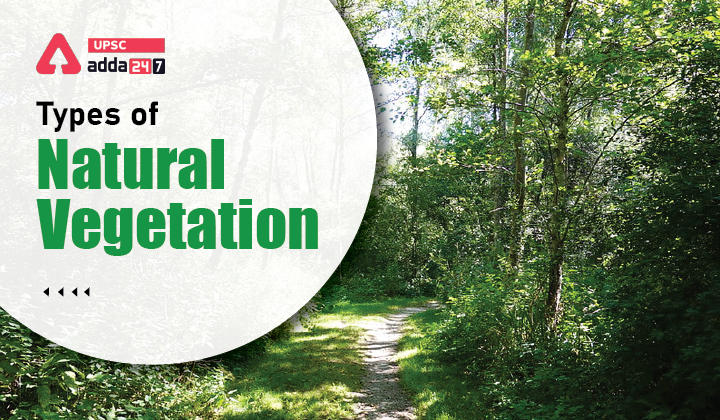Table of Contents
NATURAL VEGETATION-Introduction
India has a total geographical area of about 329 million hectares with a coastline of over 7500 km. The ecological or ecosystem diversity of the country is enormous, ranging from sea level to the highest mountainous ranges in the world; hot and arid conditions in the northwest to cold arid conditions in the trans-Himalayan region, tropical wet evergreen forests in Northeast India and the Western Ghats, mangroves of Sundarbans and fresh water aquatic to marine ecosystems.
India is one of the 12 MEGA-BIODIVERSITY countries of the world
With over 47000 plant species, India stood 10th in the world and fourth in Asia in plant diversity. 6 percent of world’s total flowering plants along with non-flowering plants like ferns, algae, and fungi exist in India. In its Fresh and Marine water, India has a total of 80000 species of animals as well as a rich variety of fish.
Naturally grown plant community without any human intervention and not disturbed by humans are known as Natural Vegetation. These are also known as Virgin Vegetation.
- Cultivated crops and fruits, orchards form part of vegetation but not natural vegetation.
- Endemic species– Purely Indian virgin vegetation. Example-Nepenthes Khasiana is an endemic plant to India. It is the only species of pitcher plant which is endemic to our country.
- Exotic species– Species that have come from outside. Example-Water Hyacinth (Eichhornia crassipes) and Giant Salvinia (Salvinia molesta), present in the backwaters of the Kuttanad region,Kerala.
FACTORS AFFECTING NATURAL VEGETATION
Flora (used to denote plants of a particular region or period) and Fauna (the species of animals) is a part of the natural kingdom but there is a huge diversity in flora and fauna kingdom due to the factors such as
-
THE RELIEF FEATURES: –
- LAND-Nature of land influences the type of vegetation
- FERTILE LAND IS SUITABLE FOR AGRICULTURE. Example- The great plains of India.
- Undulating and rough terrains are areas where grassland and woodlands develop and give shelter to a variety of wildlife.
- SOIL-Soils provide basis for different types of vegetation.
Example-sandy soils of the desert support cactus and thorny bushes, while wet, marshy, deltaic soils support mangroves and deltaic vegetation. The hill slopes with some depth of soil have conical tree.
-
THE CLIMATIC FEATURES: –
- TEMPERATURE- The character and extent of vegetation are mainly determined by temperature along with humidity in the air, precipitation and soil. On the slopes of the Himalayas and the hills of the Peninsula above the height of 900 metres, the fall in the temperature affects the types of vegetation and its growth, and changes it from tropical to subtropical temperate and alpine vegetation.
- PHOTOPERIOD- Latitudinal differences, altitude variations, seasonal variations affect the availability of Sunlight at a particular place.
- PRECIPITATION- The amount rainfall at a particular place determines the type of vegetation that place exhibits. Example- Tropical Evergreen forests are found in the region of heavy rainfall.
- In India, almost the entire rainfall is brought in by the advancing southwest monsoon (June to September) and retreating northeast monsoons.
IMPORTANCE OF FORESTS: –
- Important part of the FOOD CHAIN and ENERGY SUPPLY
- Modify the local climate and
- Forests act as renewable resources
- Enhances the quality of environment
- Supports a variety of wildlife
- Control soil erosion
- Regulate stream flow
- Support various tribes
TYPES OF NATURAL VEGETATION IN INDIA
1.Tropical Evergreen Forest
2.Tropical Deciduous Forest
3.Tropical Thorn Forest and Scrubs
4.Montane Forest
5.Mangrove
Let’s discuss each one them in detail
TROPICAL EVERGREEN FOREST
- Generally found in the areas near the equator
- Found in the areas receiving 200 cm of annual rainfall or above
- Temperature ranges between 15-25 degree Celsius
- Also known as Tropical Rainforest
- Also known as natural Carbon sink of the world as these forests are very dense
- Commercially important trees of this forest are ebony, mahogany, rosewood, rubber and cinchona. Other important trees are Sandal Wood, Rosewood, Garjan, Mahogany, and bamboo.
- Common animals found in these forests are elephant, monkey, lemur and deer, one horned rhinoceros
- AREAS-Northeastern regions of Arunachal Pradesh, Meghalaya, Assam, Nagaland, the Western Ghats, the Tarai areas of the Himalayas, and the Andaman groups of Islands, in the hills of Khasi and Jaintia.
TROPICAL DECIDUOUS FOREST
- Found in the areas receiving rainfall in the range of 200 cm to 70 cm
- Trees shed their leaves for about 6-8 weeks in dry summer
- On the basis of availability of water, they can be classified into MOIST DECIDUOUS (found in the regions receiving rainfall in the range of 200 cm to 100cm) and DRY DECIDUOUS (found in the regions receiving rainfall in the range of 100 cm to 70 cm)
- Moist Deciduous forests are found in mostly in the eastern part of the country — northeastern states, along the foothills of the Himalayas, Jharkhand, West Odisha and Chhattisgarh, and on the eastern slopes of the Western Ghats. Teak is the most dominant species of this forest. Bamboos, Sal, Shisham, sandalwood, Khair, Kusum, arjun and mulberry are other commercially important species.
- Dry Deciduous forests are found in the rainier parts of the Peninsular plateau and the plains of Bihar and Uttar Pradesh. There are open stretches, in which Teak, Sal, Peepal and Neem grow
- Common animals found are lion, tiger, pig, deer and elephant and a huge variety of birds, lizards, snakes and tortoises
THORN FORESTS AND SCRUB
- Found in the regions receiving rainfall less than 70 cm
- Found in the north-western part of the country, including semi-arid areas of Gujarat, Rajasthan, Madhya Pradesh, Chhattisgarh, Uttar Pradesh and Haryana
- Natural vegetation consists of thorny trees and bushes
- Trees are scattered with roots penetrating deep into the soil in order to get moisture.
- Stems are succulent to conserve water and leaves are mostly thick and small to minimize evaporation
- Common animals are rats, mice, rabbits, fox, wolf, tiger, lion, wild ass, horses and camels
MONTANE FOREST
- Decrease in temperature with increasing altitude leads to the corresponding change in natural vegetation
- Wet temperate type of forests are found between a height of 1000 and 2000 metres. Evergreen broad-leaf trees, such as oaks and chestnuts predominate.
- Temperate forests containing coniferous trees, like pine, deodar, silver fir, spruce and cedar, are found between a height of 1500 and 3000 metres
- Temperate grasslands are common at higher elevations and at more than 3,600 metres above the sea level, temperate forests and grasslands give way to the Alpine vegetation which consist of trees like silver fir, junipers, pines and birches. However, they get progressively stunted as they approach the snow-line. Ultimately, through shrubs and scrubs, they merge into the Alpine grasslands which are used extensively for grazing by nomadic tribes
- Mosses and lichens form part of tundra vegetation at higher altitudes
- Common animals found in these forests are Kashmir stag, spotted dear, wild sheep, jack rabbit, Tibetan antelope, yak, snow leopard, squirrels, Shaggy horn wild ibex, bear and rare red panda, sheep and goats with thick hair
MANGROVE FOREST
- Found in the areas of coasts influenced by tides where mud and silt get accumulated on coast
- Roots of the plants submerged under water in dense mangroves
- Found in the deltas of the Ganga, the Mahanadi, the Krishna, the Godavari and the Kaveri
- Trees such as sundari trees, which provide durable hard timber, palm, coconut, keora, agar, etc., also grow in some parts of the delta.
- Royal Bengal Tiger is the famous animal in these forests. Turtles, crocodiles, gharials and snakes are also found in these forests





 TSPSC Group 1 Question Paper 2024, Downl...
TSPSC Group 1 Question Paper 2024, Downl...
 TSPSC Group 1 Answer key 2024 Out, Downl...
TSPSC Group 1 Answer key 2024 Out, Downl...
 UPSC Prelims 2024 Question Paper, Downlo...
UPSC Prelims 2024 Question Paper, Downlo...
